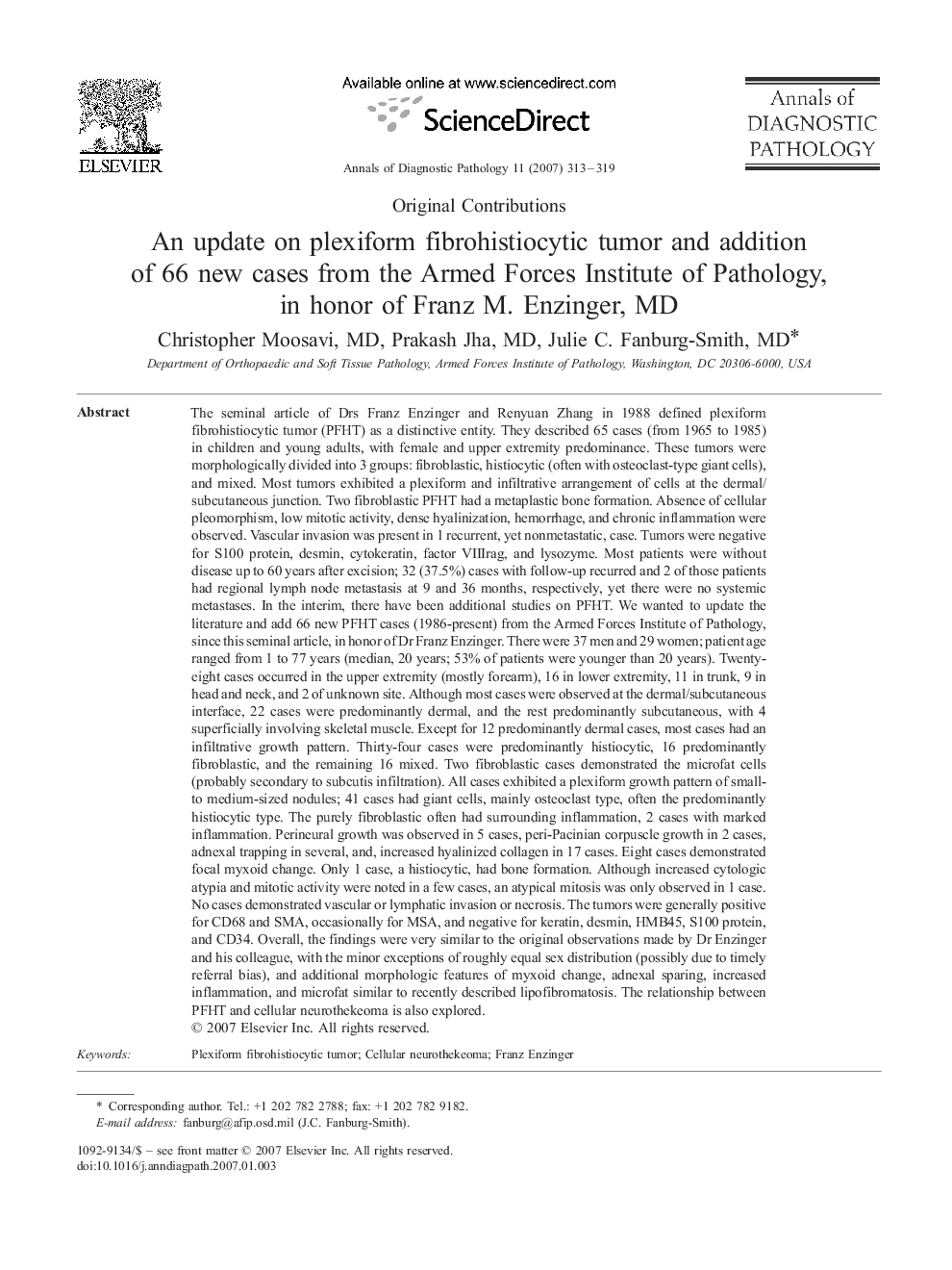| Article ID | Journal | Published Year | Pages | File Type |
|---|---|---|---|---|
| 4130277 | Annals of Diagnostic Pathology | 2007 | 7 Pages |
The seminal article of Drs Franz Enzinger and Renyuan Zhang in 1988 defined plexiform fibrohistiocytic tumor (PFHT) as a distinctive entity. They described 65 cases (from 1965 to 1985) in children and young adults, with female and upper extremity predominance. These tumors were morphologically divided into 3 groups: fibroblastic, histiocytic (often with osteoclast-type giant cells), and mixed. Most tumors exhibited a plexiform and infiltrative arrangement of cells at the dermal/subcutaneous junction. Two fibroblastic PFHT had a metaplastic bone formation. Absence of cellular pleomorphism, low mitotic activity, dense hyalinization, hemorrhage, and chronic inflammation were observed. Vascular invasion was present in 1 recurrent, yet nonmetastatic, case. Tumors were negative for S100 protein, desmin, cytokeratin, factor VIIIrag, and lysozyme. Most patients were without disease up to 60 years after excision; 32 (37.5%) cases with follow-up recurred and 2 of those patients had regional lymph node metastasis at 9 and 36 months, respectively, yet there were no systemic metastases. In the interim, there have been additional studies on PFHT. We wanted to update the literature and add 66 new PFHT cases (1986-present) from the Armed Forces Institute of Pathology, since this seminal article, in honor of Dr Franz Enzinger. There were 37 men and 29 women; patient age ranged from 1 to 77 years (median, 20 years; 53% of patients were younger than 20 years). Twenty-eight cases occurred in the upper extremity (mostly forearm), 16 in lower extremity, 11 in trunk, 9 in head and neck, and 2 of unknown site. Although most cases were observed at the dermal/subcutaneous interface, 22 cases were predominantly dermal, and the rest predominantly subcutaneous, with 4 superficially involving skeletal muscle. Except for 12 predominantly dermal cases, most cases had an infiltrative growth pattern. Thirty-four cases were predominantly histiocytic, 16 predominantly fibroblastic, and the remaining 16 mixed. Two fibroblastic cases demonstrated the microfat cells (probably secondary to subcutis infiltration). All cases exhibited a plexiform growth pattern of small- to medium-sized nodules; 41 cases had giant cells, mainly osteoclast type, often the predominantly histiocytic type. The purely fibroblastic often had surrounding inflammation, 2 cases with marked inflammation. Perineural growth was observed in 5 cases, peri-Pacinian corpuscle growth in 2 cases, adnexal trapping in several, and, increased hyalinized collagen in 17 cases. Eight cases demonstrated focal myxoid change. Only 1 case, a histiocytic, had bone formation. Although increased cytologic atypia and mitotic activity were noted in a few cases, an atypical mitosis was only observed in 1 case. No cases demonstrated vascular or lymphatic invasion or necrosis. The tumors were generally positive for CD68 and SMA, occasionally for MSA, and negative for keratin, desmin, HMB45, S100 protein, and CD34. Overall, the findings were very similar to the original observations made by Dr Enzinger and his colleague, with the minor exceptions of roughly equal sex distribution (possibly due to timely referral bias), and additional morphologic features of myxoid change, adnexal sparing, increased inflammation, and microfat similar to recently described lipofibromatosis. The relationship between PFHT and cellular neurothekeoma is also explored.
